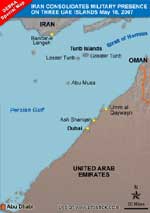Abu Dhabi Grants Iran Full License for Military Control
The rush for influence in the Arabian or Persian Gulf has accelerated as Iran’s president Mahmoud Ahmadinejad hurried over to the oil-rich Gulf emirate of Abu Dhabi last week on the heels of US Vice President Dick Cheney.
But while the American ally was greeted with quiet conversation, the red carpet was rolled out in honor of the Iranian president. He reveled in the royal airport welcome, the lavish banquets and most of all, a platform at the national soccer stadium for another fiery and threatening speech against the United States.
Ahmadinejad did not come away from his visit empty-handed.
DEBKA-Net-Weekly‘s Intelligence sources report exclusively that he signed a secret memorandum with Sheikh Khalifa bin Zayed Al Nahyan, Ruler of Abu Dhabi and President of the United Arab Emirates.
This document resolved a 37-year old dispute over three strategic islands in the eastern part of the Strait of Hormuz, Abu Musa, Lesser Tunb and Greater Tumb (See attached map), which the Shah overran in 1970 and to which his Islamic successors have clung ever since.
For some years, joint sovereignty was maintained until 1992, when Iran asserted full control of Abu Musa. In the next two years, Iran established Revolutionary Guards bases on the islands, as well as anti-aircraft missile batteries, artillery and Silkworm shore-to-ship missiles.
However, last week, Sheikh Khalifa succumbed to the status quo by signing away UAR control of the three disputed islands to Tehran, for use as armed Iranian enclaves in the Hormuz chokepoint of the Persian Gulf. Iran’s control has been formalized and the three islands granted a status similar to that of the Alexandretta enclave on the Syrian-Turkish border, over which Syria never ceded its claim of sovereignty but accepted Turkish rule.
The Abu Dhabi emir further honored the visiting Iranian president by releasing twelve Iranian divers arrested in UAE waters.
Certain Gulf publications misreported an offer by Ahmadinejad to revert to a previous agreement for Abu Musa to be ruled jointly, with Iran giving up single sovereignty over the island and pledging to halt the demographic and geographical changes supporting its single rule.
Flying kamikaze bombs, shore-to-ship missiles, mini-submarines
 According to DEBKA-Net-Weekly‘s Gulf sources, Sheikh Khalifa and Ahmadinejad signed a deal that left all three islands in Iranian hands, albeit under formal UAR sovereignty.
According to DEBKA-Net-Weekly‘s Gulf sources, Sheikh Khalifa and Ahmadinejad signed a deal that left all three islands in Iranian hands, albeit under formal UAR sovereignty.
Abu Musa and the two Tunbs gained enormously in strategic value after the US invaded Iraq in 2003. Iran accordingly launched an ambitious project to upgrade the military facilities there. Naval installations went up on Abu Musa to accommodate the home-made Iranian Kilo-class mini-submarines, designed for operation in the fairly shallow Persian Gulf waters, along with batteries of C-802 shore-to-ship missiles, the most advanced of their kind in the market. The Revolutionary Guards stationed marine raider units on the island, equipped with fast commando craft capable of attacking large vessels such as aircraft carriers or giant oil tankers. It was supplemented with anti-submarine and minesweeping helicopter units.
In the last two months, the islands’ air defenses have been upgraded with newly-manufactured Iranian anti-air missile batteries, DEBKA-Net-Weekly‘s military sources report.
The tunnels burrowed at the center of Abu Musa are believed to conceal a mixed missile arsenal and light aircraft to be used as flying bombs. Packed with explosives, they can be flown by suicide pilots on kamikaze runs against enemy vessels.
Military experts in the Gulf estimate that the Revolutionary Guards have built up their presence on Abu Musa and the two Tunbs to more than 7,000 personnel.
Cheney was wise to the Iranian-UAR deal when he met Abu Dhabi and Saudi leaders Friday, May 11. When he challenged Sheikh Khalifa, the UAE President replied coolly: You Americans are planning to attack Iran in any case, so the deal will be curtailed very soon – within a year or 18 months at most. After you have finished fighting Iran, the islands will naturally revert to the UAE. So what is the point of us quarrelling with Tehran in the interim?
This attitude underlines the problem dogging US Middle East policy. Even after Washington directly assures regional rulers that a military attack on Iran is certain, they refuse to sit around and wait for this to happen and instead cozy up to Tehran, safe in the knowledge that rewards will be theirs to pick up when the US eventually goes into action.
Washington is also suffering from diminishing credibility in the region from the unresolved Iraqi crisis and impending troop exit, especially when compared with Iran’s proactive diplomacy and aggressive moves. Sunday, high-ranking Kuwaiti government security officials visited Tehran to “exchange views with Iranian security officials on the enforcement of joint security cooperation.” Monday and Tuesday, May 14 and 15, the Iranian president spent in Oman.
The US vice president did his best to turn the negative tide somewhat by delivering a piece of sensational news to Saudi King Abdullah and UAE president Sheikh Khalifa.
It is revealed in the next article in this issue.


